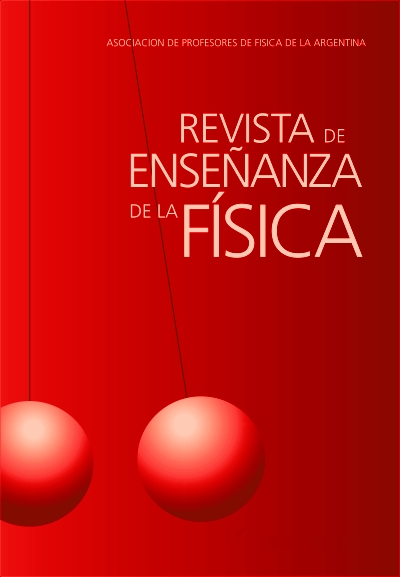Activities to address the Newtonian gravitational force in physics undergraduate courses
DOI:
https://doi.org/10.55767/2451.6007.v30.n1.20320Keywords:
Gravitational force, Activities, Misconceptions, Higher education, Action and reactionAbstract
We start from the identification of a misconception among physics students: that in binary systems with greater total mass the intensity of the gravitational force is necessarily greater. In search of ways to confront it, in this text we suggest activities structured from analyses on the effect of the mass distribution on the intensity of the gravitational force. The activities were planned to last three or four class hours. In the first one, we propose that students compare the intensities of the gravitational forces acting on the Earth-Moon and Uranus-Miranda systems. After the students explain their considerations on the problem, we suggest that the teacher present: i) analyzes that show that the gravitational force in a binary system is maximum when the distribution of the total mass occurs homogeneously between the bodies; and ii) a possible explanation for this result based on Newton's 3rd Law of Motion. Exploratory applications of these activities gave us indications of their plausibility, evidencing that the students' knowledge about gravitational force is usually assimilated in a mnemonic way, without reflections on the fact that the calculation of the intensity of this force involves the product and not the sum of the masses.References
Bar, V. (1989). Introducing mechanics at the elementary school. Physics Education, 24(6), 348–352.
Cindra, J. L. (1996). Anomalias e paradoxos da teoria newtoniana da gravitação. Revista da SBHC, 16, 53-60.
Freire Jr., O., Matos Filho, M., e Valle, A. L. (2004). Uma exposição didática de como Newton apresentou a força gravitacional. Física na Escola, 5(1), 25-31.
Galili, I. e Bar, V. (1997). Children’s operational knowledge about weight. International Journal of Science Education, 19(3), 317-340.
Gravina, M. H., e Buchweitz, B. (1994). Mudanças nas concepções alternativas de estudantes relaciona-das com eletricidade. Revista Brasileira de Ensino de Física, 16, 1-4.
Nasa. (s/d). Solar System and Beyond – Planets, Moons and Dwarfs Planets. Disponível em: <https://www.nasa.gov/content/planets-moons-and-dwarf-planets>. Acesso em: 26 mar. 2018.
Neves, M. C. D. (2000). Uma investigação sobre a natureza do movimento ou sobre uma história para a noção do conceito de força. Revista Brasileira de Ensino de Física, 22(4), 543-556.
Osborne, R. J., e Gilbert, J. K. (1980). A method for investigated concept understanding in science. Euro-pean Journal of Science Education, 2(3), 311–321.
Philips, W. C. (1991) Earth science misconceptions. Science Teaching, 58(2), 21–23.
Piburn, M. D., Baker, D. R., e Treagust, D. F. (1988). Misconceptions about gravity held by college stu-dents. Annual Meeting of the National Association for Research in Science Teaching.
Ruggiero, S., Cartelli, A., Dupre, F., e Vincentinimissoni, M. (1985). Weight, gravity and air pressure: Mental representations by Italian middle school pupils. European Journal of Science Education, 7(2), 181-194.
Smith, C.,e Treagust, D. (1988). Not understanding gravity limits students' comprehension of astronomy concepts. The Australian Science Teachers Journal, 33(4), 21-24.
Treagust, D. F., e Smith C. L. (1989). Secondary students understanding of gravity and the motions of planets. School Science Math, 89(5), 380–391.
Varela-Losada, M., Pérez-Rodríguez, U., Álvarez-Lires, M., e Arias-Correa, A. (2015). Concepciones alternativas sobre Astronomía de profesorado español en formación. Ciência & Educação, 21(4), 799-816.
Young, H. D., e Freedman, R. A. (2016a). Física I: mecânica, 14ª ed. São Paulo: Pearson Education do Brasil.
Young, H. D., e Freedman, R. A. (2016b). Física II: termodinâmica e ondas, 14ª ed. São Paulo: Pearson Education do Brasil.
Downloads
Published
Issue
Section
License
Copyright (c) 2018 Paulo Henrique Eleutério Falsetti, André Coelho da Silva

This work is licensed under a Creative Commons Attribution-NonCommercial-NoDerivatives 4.0 International License.
Aquellos autores/as que tengan publicaciones con esta revista, aceptan los términos siguientes:Los autores/as conservarán sus derechos de copiar y redistribuir el material, bajo los términos estipulados en la Licencia de reconocimiento, no comercial, sin obras derivadas de Creative Commons que permite a terceros compartir la obra bajo las siguientes condiciones:
- Reconocimiento — Debe reconocer adecuadamente la autoría, proporcionar un enlace a la licencia e indicar si se han realizado cambios. Puede hacerlo de cualquier manera razonable, pero no de una manera que sugiera que tiene el apoyo del licenciador o lo recibe por el uso que hace.
- NoComercial — No puede utilizar el material para una finalidad comercial.
- SinObraDerivada — Si remezcla, transforma o crea a partir del material, no puede difundir el material modificado.
- Los autores/as podrán adoptar otros acuerdos de licencia no exclusiva de distribución de la versión de la obra publicada (p. ej.: depositarla en un archivo telemático institucional o publicarla en un volumen monográfico) siempre que se indique la publicación inicial en esta revista.
- Se permite y recomienda a los autores/as difundir su obra a través de Internet (p. ej.: en archivos telemáticos institucionales o en su página web) antes y durante el proceso de envío, lo cual puede producir intercambios interesantes y aumentar las citas de la obra publicada. (Véase El efecto del acceso abierto).










